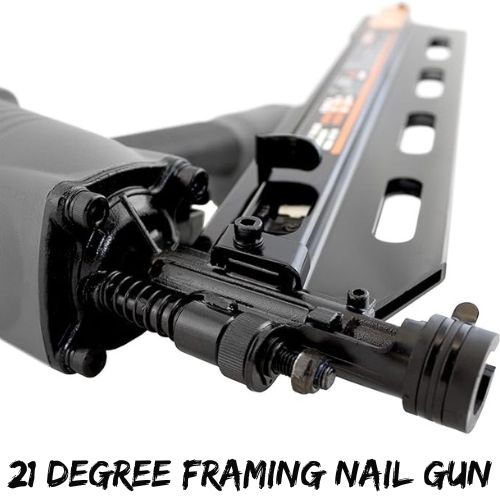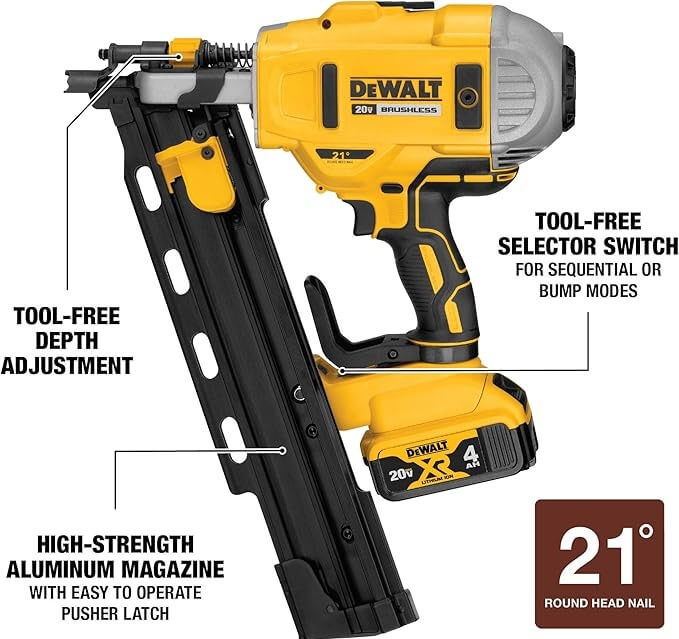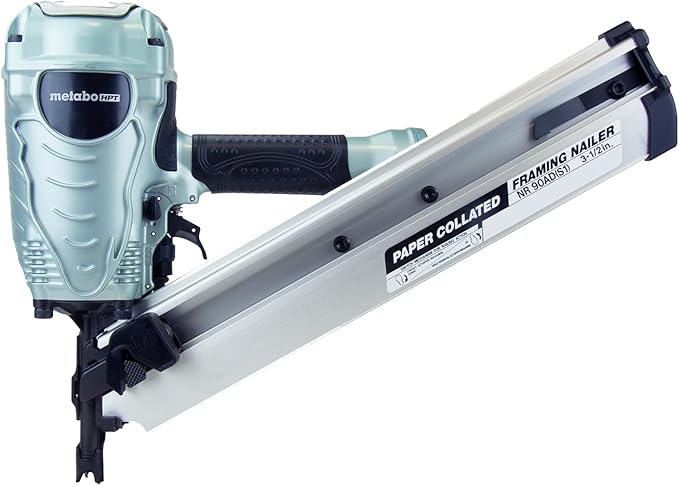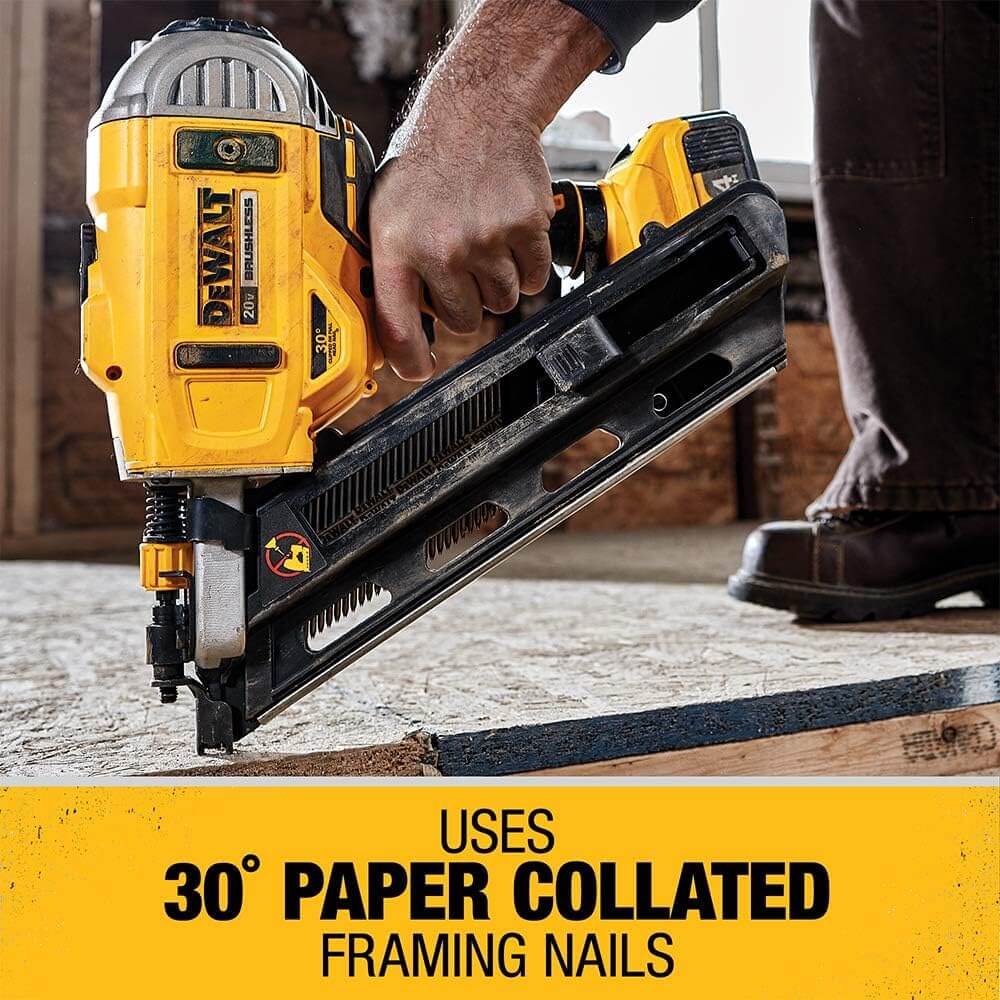Framing is a critical part of any construction project, so you need to make sure you have the right tools for the job. In this article, we will compare 21 vs 30 degree framing nailer so that you can make an informed decision about which one is right for your needs.
A framing nailer is a crucial tool that will make your life a lot easier. The angle of the framing nailer is one of the most important features to consider as it will determine how the nail is driven into the wood.
There are two common angles for framing nailers, 21-degree and 30-degree. Each angle has its advantages and disadvantages that you need to be aware of before making a purchase.
What is a 21 Degree Framing Nailer?
As the name suggests, a 21-degree framing nailer has a 21-degree angle. However, it’s not exactly 21 degrees, it ranges from 20 to 22 degrees making it slightly more angled than a 30-degree nailer. The smaller the angle, the easier it is to drive the nails into the wood.
21-degree framing nailers are designed for use with thicker and denser materials. It’s mostly used in construction projects that require a stronger hold and more power. The smaller angle also makes it easier to drive the nails into tight spaces.

The nails used in 21-degree framing nailers are round-headed, which is ideal for sinking the nails into the wood without damaging it. The round head also provides a better grip, making it less likely for the nail to slip out.
The fasteners of a 21-degree nailer use a plastic strip rather than a wire coil and it can hold up to 70 nails. The plastic strip is less likely to jam than the wire coil and it’s also easier to load.
You can fit a 21-degree framing nailer into tighter spaces. The smaller size also makes it more balanced and easier to maneuver.
Pros & Cons of 21 Degree Framing Nail Gun
Pros
- Ideal for thicker and denser materials
- The smaller angle makes it easier to drive nails into tight spaces
- Plastic strips are less likely to jam and easier to load
- More balanced and easier to maneuver
Cons
- Need proper maintenance
- Heavier and more expensive
What is a 21 Degree Nailer Used for?

Since a 21-degree framing nailer uses heavier and thicker nails, it is best for large projects, such as building a house or framing a commercial building. If you are working on a project that requires more holding power from the nails, then a 21-degree framing nailer is the best option.
Here are its main uses:
- Building house frames, walls, and ceilings
- Constructing wooden decks, patios, and porches
- Fencing
- Build roof trusses and rafters.
- Assembling sheds, barns, and garages
- Making gazebos, pergolas, and other outdoor structures
- Home remodeling projects like adding walls, extensions, or new floors.
What is a 30 Degree Framing Nailer?
So now that we have looked into the 21-degree framing nailer, let’s take a look at the 30-degree framing nailer. Just like 21-degree nailers, 30-degree framing nailers also range from 30 degrees to 34 degrees.
30-34 degrees is a good angle, however, if you are working on a tighter space, a smaller angle would be better.

However, it can be used as an all-purpose tool and can be used for multiple tasks such as framing, subflooring, roofing, and sheathing. When you are framing, this nailer can help you create a strong and secure foundation.
Pros & Cons of 30 Degree Framing Nail Gun
Pros
- It can be used for multiple tasks
- Uses a clipped head nails which leaves a smaller hole
- The paper strip can hold up to 80 nails
- Affordable
Cons
- Less powerful
- Not ideal for tight places
What is a 30 Degree Framing Nail Gun Used for?

A 30-degree framing nailer can be used for various things, like frames, roofs, and floors. The nailer will help you make strong joints when you use it for frames.
It is powerful and can help you finish the job quickly and easily. If you are looking for a versatile and dependable framing nailer, then a 30-degree model is a great option for you.
Here are its main uses:
- Framing construction in tight corners and between studs.
- Installing roof trusses, rafters, and sheathing.
- Adding new walls, extensions, and renovations in tight or awkward spaces.
- Attaching plywood, OSB panels, and siding.
- Deck boards and subflooring.
- Angled and overhead nailing.
Gaps in Usage Between 21 Degree & 30 Degree Framing Nailers
Here are the gaps in usage between 21 degree and 30 degree framing nailers—where one is better suited than the other or where their applications do not overlap.
Here are the main gaps:
| Use Cases or Applications | 21 Degree Framing Nailer | 30 Degree Framing Nailer | Gap Identified |
| Tight Spaces & Corners | Harder to fit due to wider magazine angle. | Harder to fit due to the wider magazine angle. | 21-degree nailers struggle in tight areas. |
| Framing & Heavy-Duty Work | Stronger hold with full round head nails. | Works well but some nails may not comply with building codes. | 30-degree may face restrictions due to clipped-head nails. |
| Outdoor Construction like fencing or decking | Preferred for strength & durability. | Usable but not always ideal for heavy-duty outdoor projects | 21-degree has better nail-holding power for outdoor use. |
| Roofing & Overhead Nailing | Bulkier, harder to maneuver overhead. | Lightweight, easier to handle overhead. | 30-degree is better for roofing due to lighter weight. |
Difference Between 21 and 30 Degree Framing Nailer
Magazine Angle & Nail Strips
21-Degree Framing Nailer
- Has a 21 degree angled magazine (the part that holds the nails).
- Uses plastic connected nails, held together with plastic strips.
- Plastic strips break apart when nails are fired and leave small bits behind.
30-Degree Framing Nailer
- Has a 30 to 34 degree angled magazine.
- Uses paper connected nails that are held together with paper strips.
- Paper strips break down easily.
Nail Capacity & Reloading
21-Degree Nailer
- Holds 60–70 nails at a time.
- Needs to be reloaded more often during big projects.
30-Degree Nailer
- Holds 90–100 nails, so it can be used for a longer time before reloading.
- Helps save time on larger projects.
Weight & Ease of Use
21-Degree Nailer
- A bit bigger and heavier because of the wider magazine.
- Can feel tiring when used for a long time.
- Harder to fit into tight spaces like corners.
30-Degree Nailer
- Smaller and lighter, so it’s easier to handle.
- Works better in small spaces and overhead jobs.
Nail Holding Strength & Building Rules
21-Degree Nails
- Have full round heads that hold materials strongly.
- Meet most building safety rules in the U.S.
- Great for projects where a strong grip is needed, like framing houses.
30-Degree Nails
- Often have flat or smaller round heads.
- Some building rules don’t allow flat head nails because they don’t hold as well.
- Double check local rules before using them for larger projects.
Nail Gun Jamming & Cleanup
21-Degree Nailer
- Plastic strips can cause nail gun jams that may slow down your work performance.
- Leaves tiny plastic pieces that need to be cleaned up properly.
30-Degree Nailer
- Paper strips jam less to keep your job smooth.
- The paper breaks apart naturally and leaves less mess.
Best Uses
21-Degree Nailer
- Works well for framing, fences, and decks.
- Best when strong nails are needed.
30-Degree Nailer
- Good for framing, roofing, and tight spaces.
- Easier to use in hard-to-reach spots.
Nail Cost & Availability
21-Degree Nails
- Easier to find in most hardware stores.
- Usually cheaper than 30-degree nails.
30-Degree Nails
- A bit pricier and not always in stock at local stores.
- May need to be ordered ahead.
Safety Considerations
21-Degree Nailer
- Plastic pieces from nails can be dangerous if not cleaned up.
- Can cause slipping or eye injuries if scattered around.
30-Degree Nailer
- Safer because it doesn’t leave sharp plastic bits.
- Less cleanup is needed after work.
Best for Homeowners vs. Professionals
21-Degree Nailer
- Popular with DIYers and homeowners because it’s affordable.
- Works well for small projects like home repairs.
30-Degree Nailer
- Favored by professionals because it’s lighter and holds more nails.
- Saves time and effort on big construction jobs.
21 vs 30 Degree Framing Nailer – At a Glance
| Features | 21 Degree Framing Nailer | 30 Degree Framing Nailer |
| Magazine Angle | 21 degree angle | 30 to 34 degree angle |
| Nail Strip Type | Plastic-connected nails | Paper-connected nails |
| Nail Capacity | 60–70 nails per load | 90–100 nails per load |
| Reloading | More frequent reloading | Less frequent reloading |
| Size & Weight | Bigger & heavier | Smaller & lighter |
| Ease of Use | Harder to use in tight spaces | Easier to maneuver in small areas |
| Holding Strength | Uses full round head nails | Uses flat or offset head nails |
| Building Code Compliance | Allowed by most U.S. codes | Some codes don’t allow flat-head nails |
| Jamming Issues | Plastic strips may jam the nailer | Paper strips jam less often |
| Cleanup | Leaves small plastic bits | Paper breaks down naturally, leaving less mess |
| Best Uses | Framing, fences, decks | Framing, roofing, tight spaces |
| Nail Cost & Availability | Cheaper & easier to find | More expensive & less available |
| Safety Considerations | Plastic pieces can cause injuries/slipping | Safer, no sharp plastic debris |
| Best For | DIYers & general users | Professionals & contractors |
Which is better 21 or 30 Degree Framing Nailer
Just like any other tool, it depends on the project you are working on. If you need more power and holding strength, then a 21-degree nailer would be a better choice.
If you are looking for something versatile that can be used for multiple projects, then a 30-degree framing nailer would be a better option.
It just comes down to what you need the nailer for and what your budget is. It’s up to the person who’s in charge of the project to decide which one is better for their needs.
However, both nailers are great for framing, it’s just that they are used for different purposes. If you are working on a project that requires more power, then go with the 21-degree nailer.
If you need something versatile, then the 30-degree nailer is a great option.
Final Verdict – 21 or 30 Degree Framing Nailer
So there you have it! Now you know the differences between a 21 vs 30-degree framing nailer. It comes down to what you need the nailer for and what your budget is.
If you are working on a project that requires more power, then go with the 21-degree nailer. If you need something versatile, then the 30-degree nailer is a great option.
Make sure to consider your purpose and then decide which one is the better fit for you.
FAQs
Can I use 30 degree nails in a 34 degree framing nailer for framing?
Ans: Yes, 30-degree nails can be used in a 34-degree framing nailer. This is because the magazines that are used in 34-degree framing nailers are designed to work with both 30 and 34-degree nails.
We’ve also mentioned in the beginning that 30-degree nailers can range up to 34 degrees, so it’s perfectly fine to use them in a 34-degree nailer.
However, some brands may have different recommendations, so it’s always best to check the manufacturer before using the nails in a framing nailer.
Can I use 30 degree nails in a 28 degree gun for framing?
Ans: No, you cannot use 30-degree nails in a 28-degree gun. This is because the magazine for a 28-degree nailer is not designed to work with 30-degree nails. The magazine is too narrow and the nails will not fit properly. If you force them in, it could damage the magazine and cause the gun to jam. 30-degree nails can range from 30-34 degrees, so it’s best to use them in a 30-degree or 34-degree nailer.
Can I use 30 degree nails in a 21 degree nail gun?
Ans: Again, no! You cannot use 30-degree nails in a 21-degree nail gun. The magazine for a 21-degree nail gun is too narrow and the nails will not fit properly. If you force them in, it could damage the magazine and make the gun jam. So if you have a 21-degree nail gun, make sure to only use 21-degree nails. If you want to work with 30-degree nails, then you’ll need a 30-degree or 34-degree nail gun.
Can I use 21 degree nails in a 20 degree nailer for framing?
Ans: Yes, you can use 21-degree nails in a 20-degree nailer. This is because the magazine for a 20-degree nailer is designed to work with both 20 and 21-degree nails. Every nailer has a 3-4 degree tolerance, so it’s perfectly fine to use 21-degree nails in a 20-degree nailer. If you have a 20-degree nailer, you can use up to 23-24-degree nails.
Can you use 30 degree nails in a 33 degree nailer for framing?
Ans: Yes, you can perfectly use 30-degree nails in a 33-degree nailer. You can use them in any 30-34 degree nailer. This is because the magazines for these nailers are designed to work with both 30 and 34-degree nails.
The only exception would be if you have a 20-degree or 21-degree nail gun, then you can only use 20 or 21-degree nails. Every nailer has a 3-4 degree tolerance, so it’s perfectly fine to use 30-degree nails in a 33-degree nailer
Can you use 21 degree nails in a 30 degree gun for framing?
Ans: No, it’s not possible to use 21-degree nails in a 30-degree gun. The magazine for a 30-degree nailer is not designed to work with 21-degree nails. Your nailer will get jammed and might not work properly anymore.
If you want to use 21-degree nails, then you’ll need a 21-degree or 20-degree nail gun and not a 30-degree nailer.

